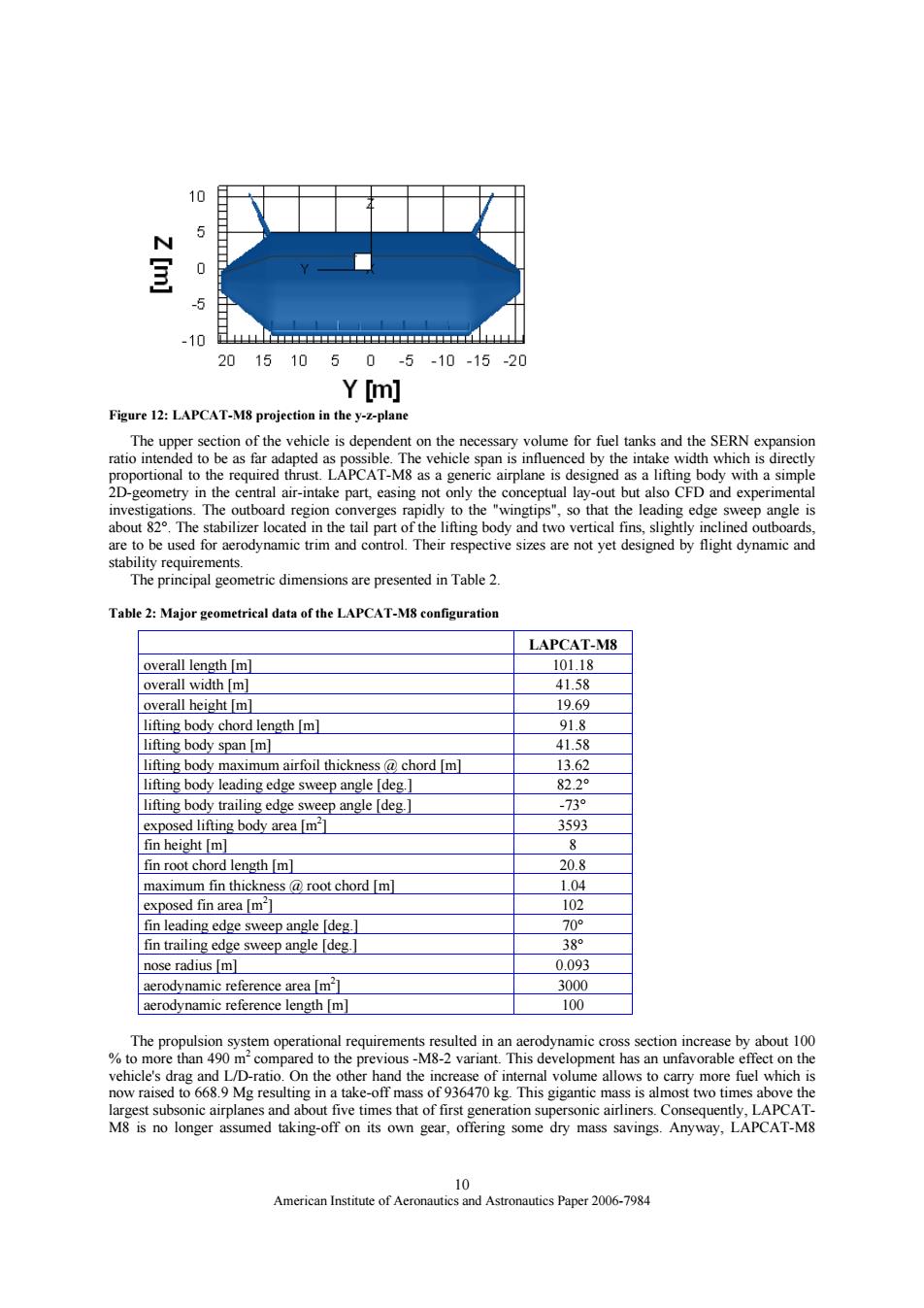正在加载图片...

10 5 N -5 .10 LLL4山 201510 50-5-10-15-20 Y[m] Figure 12:LAPCAT-M8 projection in the y-z-plane The upper section of the vehicle is dependent on the necessary volume for fuel tanks and the SERN expansion ratio intended to be as far adapted as possible.The vehicle span is influenced by the intake width which is directly proportional to the required thrust.LAPCAT-M8 as a generic airplane is designed as a lifting body with a simple 2D-geometry in the central air-intake part,easing not only the conceptual lay-out but also CFD and experimental investigations.The outboard region converges rapidly to the "wingtips",so that the leading edge sweep angle is about 82.The stabilizer located in the tail part of the lifting body and two vertical fins,slightly inclined outboards, are to be used for aerodynamic trim and control.Their respective sizes are not yet designed by flight dynamic and stability requirements. The principal geometric dimensions are presented in Table 2 Table 2:Major geometrical data of the LAPCAT-M8 configuration LAPCAT-M8 overall length [m] 101.18 overall width [m] 41.58 overall height [m] 19.69 lifting body chord length [m] 91.8 lifting body span [m] 41.58 lifting body maximum airfoil thickness chord [m] 13.62 lifting body leading edge sweep angle [deg.] 82.2° lifting body trailing edge sweep angle [deg. -73° exposed lifting body area [m2] 3593 fin height [m] P fin root chord length [m] 20.8 maximum fin thickness root chord [m] 1.04 exposed fin area [m2] 102 fin leading edge sweep angle [deg.] 70° fin trailing edge sweep angle [deg.] 38° nose radius [m] 0.093 aerodynamic reference area [m] 3000 aerodynamic reference length [m 100 The propulsion system operational requirements resulted in an aerodynamic cross section increase by about 100 to more than 490 m2compared to the previous-M8-2 variant.This development has an unfavorable effect on the vehicle's drag and L/D-ratio.On the other hand the increase of internal volume allows to carry more fuel which is now raised to 668.9 Mg resulting in a take-off mass of 936470 kg.This gigantic mass is almost two times above the largest subsonic airplanes and about five times that of first generation supersonic airliners.Consequently,LAPCAT- M8 is no longer assumed taking-off on its own gear,offering some dry mass savings.Anyway,LAPCAT-M8 10 American Institute of Aeronautics and Astronautics Paper 2006-7984American Institute of Aeronautics and Astronautics Paper 2006-7984 10 Figure 12: LAPCAT-M8 projection in the y-z-plane The upper section of the vehicle is dependent on the necessary volume for fuel tanks and the SERN expansion ratio intended to be as far adapted as possible. The vehicle span is influenced by the intake width which is directly proportional to the required thrust. LAPCAT-M8 as a generic airplane is designed as a lifting body with a simple 2D-geometry in the central air-intake part, easing not only the conceptual lay-out but also CFD and experimental investigations. The outboard region converges rapidly to the "wingtips", so that the leading edge sweep angle is about 82°. The stabilizer located in the tail part of the lifting body and two vertical fins, slightly inclined outboards, are to be used for aerodynamic trim and control. Their respective sizes are not yet designed by flight dynamic and stability requirements. The principal geometric dimensions are presented in Table 2. Table 2: Major geometrical data of the LAPCAT-M8 configuration LAPCAT-M8 overall length [m] 101.18 overall width [m] 41.58 overall height [m] 19.69 lifting body chord length [m] 91.8 lifting body span [m] 41.58 lifting body maximum airfoil thickness @ chord [m] 13.62 lifting body leading edge sweep angle [deg.] 82.2° lifting body trailing edge sweep angle [deg.] -73° exposed lifting body area [m2 ] 3593 fin height [m] 8 fin root chord length [m] 20.8 maximum fin thickness @ root chord [m] 1.04 exposed fin area [m2 ] 102 fin leading edge sweep angle [deg.] 70° fin trailing edge sweep angle [deg.] 38° nose radius [m] 0.093 aerodynamic reference area [m2 ] 3000 aerodynamic reference length [m] 100 The propulsion system operational requirements resulted in an aerodynamic cross section increase by about 100 % to more than 490 m2 compared to the previous -M8-2 variant. This development has an unfavorable effect on the vehicle's drag and L/D-ratio. On the other hand the increase of internal volume allows to carry more fuel which is now raised to 668.9 Mg resulting in a take-off mass of 936470 kg. This gigantic mass is almost two times above the largest subsonic airplanes and about five times that of first generation supersonic airliners. Consequently, LAPCATM8 is no longer assumed taking-off on its own gear, offering some dry mass savings. Anyway, LAPCAT-M8